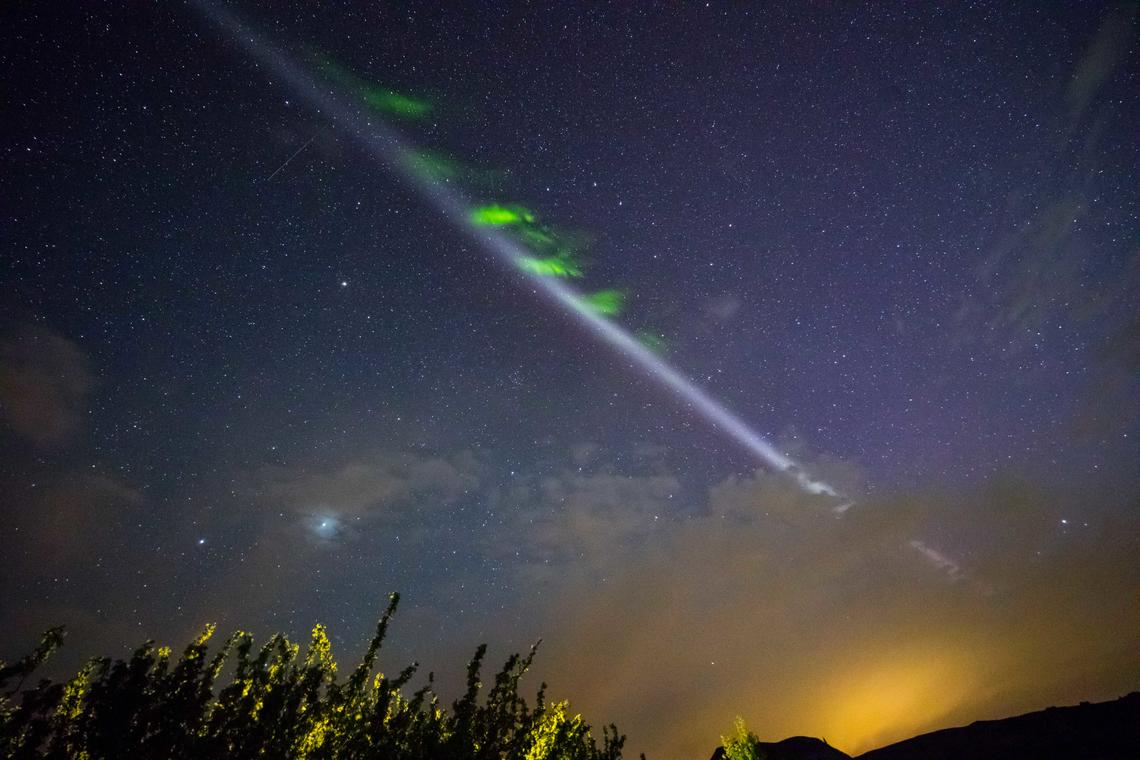March 15, 2018
Space physicists and citizen scientists shed light on the mystery of STEVE

STEVE is slender, bright and gorgeous — and still something of a mystery.
In fact, STEVE — a glowing ribbon of light running east-west in the night sky — may not even be an aurora like the familiar aurora borealis, or northern lights. Visible aurora are caused by electrons coming down Earth’s magnetic fields lines and hitting the upper atmosphere, where they energize atoms and molecules and produce the dazzling ‘dancing’ light.
“So far, with STEVE we can’t find any evidence that there are electrons coming down,” says Faculty of Science space physicist Eric Donovan, professor in the Department of Physics and Astronomy and director of the Auroral Imaging Group at the University of Calgary.
“I think it’s probably not an aurora, certainly not a traditional aurora,” he says.
Amateur photographers of the night sky have captured images of STEVE for decades. But this phenomenon only came to the attention of the scientific community two years ago because of a chance encounter between Donovan and a Facebook group called the Alberta Aurora Chasers.
Donovan and other UCalgary space physicists, along with scientists in Alberta and the U.S. and U.K., and two Alberta aurora Chasers, have co-authored a new paper describing what is known so far about STEVE.
Their paper, “New Science in Plain Sight: Citizen Scientists Lead to Discovery of Optical Structure in the Upper Atmosphere,” is published in Science Advances, an online, peer-reviewed journal of the American Association for the Advancement of Science.

STEVE, as seen over Starland County, Alta., appears as an unmistakably bright ribbon.
Neil Zeller, Neil Zeller Photography
STEVE appears to tie together two regions of space
The team’s paper proposes a scientific name for STEVE — Strong Thermal Emission Velocity Enhancement — based on measurements of its ion (electrically charged atoms and molecules) properties and the aurora chasers’ original name for the phenomenon.
Thanks to analysis of photos by the citizen scientists, along with satellite and ground-based sensors, STEVE is now officially recognized as “a new observable arc boundary visible at sub-auroral latitudes.”
STEVE occurs in a “critical magnetosphere-ionosphere coupling region” that should be targeted for more study, as “STEVE appears to tie these two separate regions of space together,” says the team’s paper. STEVE also shows distinctly different colours compared with common types of aurora. The aurora’s brightest colour is green (caused by an emission in atomic oxygen at a specific wavelength), with some red below and, occasionally, violet. STEVE, on the other hand, is a lighter-coloured mauve.
Observations from a European Space Agency satellite named Swarm as it crossed STEVE at 450 kilometres above Earth’s surface revealed unusually high temperatures and a very strong westward flow of ions.
Donovan theorizes that activity in Earth’s magnetosphere, some 55,000 to 75,000 km out in space, is "throwing" material at the Earth that travels along magnetic field lines until the increasing strength of the field stops the material and pushes it sideways.
“That sets up a series of electric fields that map down into the ionosphere and those electric fields make things move really fast in the ionosphere in a very narrow region,” Donovan says. The intense heating in the upper atmosphere, with “hundreds of emissions being simultaneously excited,” produces STEVE’s light.

STEVE near Exshaw looking toward Canmore, with the Three Sisters Mountain Range reflected.
Chris Cully, Faculty of Science
STEVE visible to millions of people
STEVE appears periodically as an unmistakably bright ribbon, extending for hundreds of thousands of kilometres, that can be seen by millions of people, from southern Ontario and Michigan all the way north into Canada and up to Alaska.
To unravel STEVE’s mystery, Chris Cully, associate professor of physics and astronomy in the Faculty of Science, has built small spectrometers, attached to two digital cameras, that can capture photos of the spectral content of STEVE’s light. That will help identify the types of emissions and why STEVE is mauve-coloured.
The cameras will be used by the Alberta Aurora Chasers, who Donovan calls “phenomenally talented photographers of the night sky. We wouldn’t even know about STEVE if it wasn’t for these citizen scientists.”
Chris Ratzlaff, administrator for the Alberta Aurora Chasers, says being co-authors on the scientific paper and having the original name STEVE retained “is empowering for the entire community of aurora citizen science, and encouraging to the broader citizen science community and their own areas of scientific research.”
It is “amazing” that the Alberta Aurora Chasers will continue to have an integral role in learning more about STEVE, Ratzlaff adds. “Our members are located throughout areas favoured by STEVE. This will enable us to get the spectrometer-cameras to the right spots to photograph and analyze STEVE.”
Researchers also will continue to observe STEVE with the Swarm satellite and likely also with ground-based infrared scatter radar in Alaska.
Funding for researching STEVE comes from the Canadian Space Agency, Canada Foundation for Innovation, Danish Technical University and the European Space Agency.
Contribute to the University of Calgary’s AuroralZone and check out the Canadian Space Agency’s AuroraMax public outreach program.
